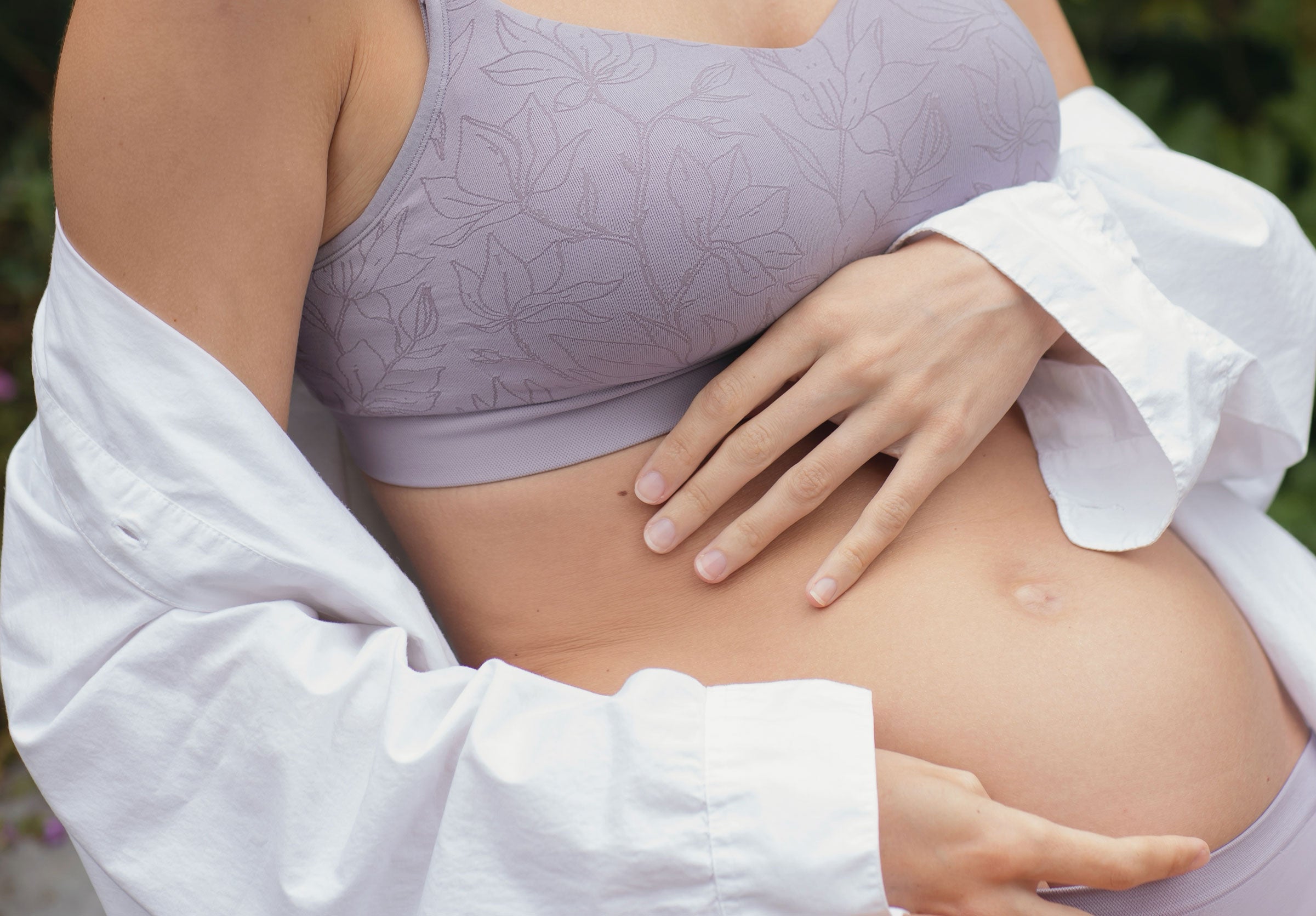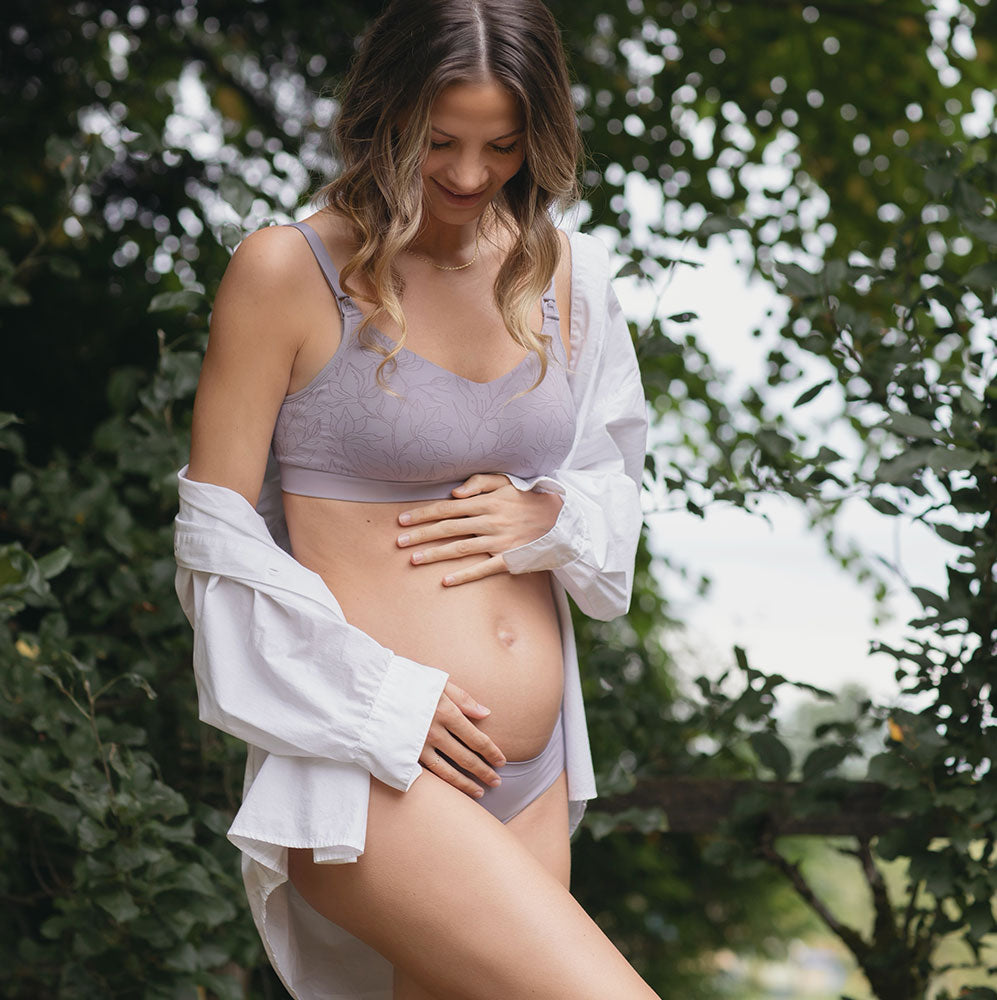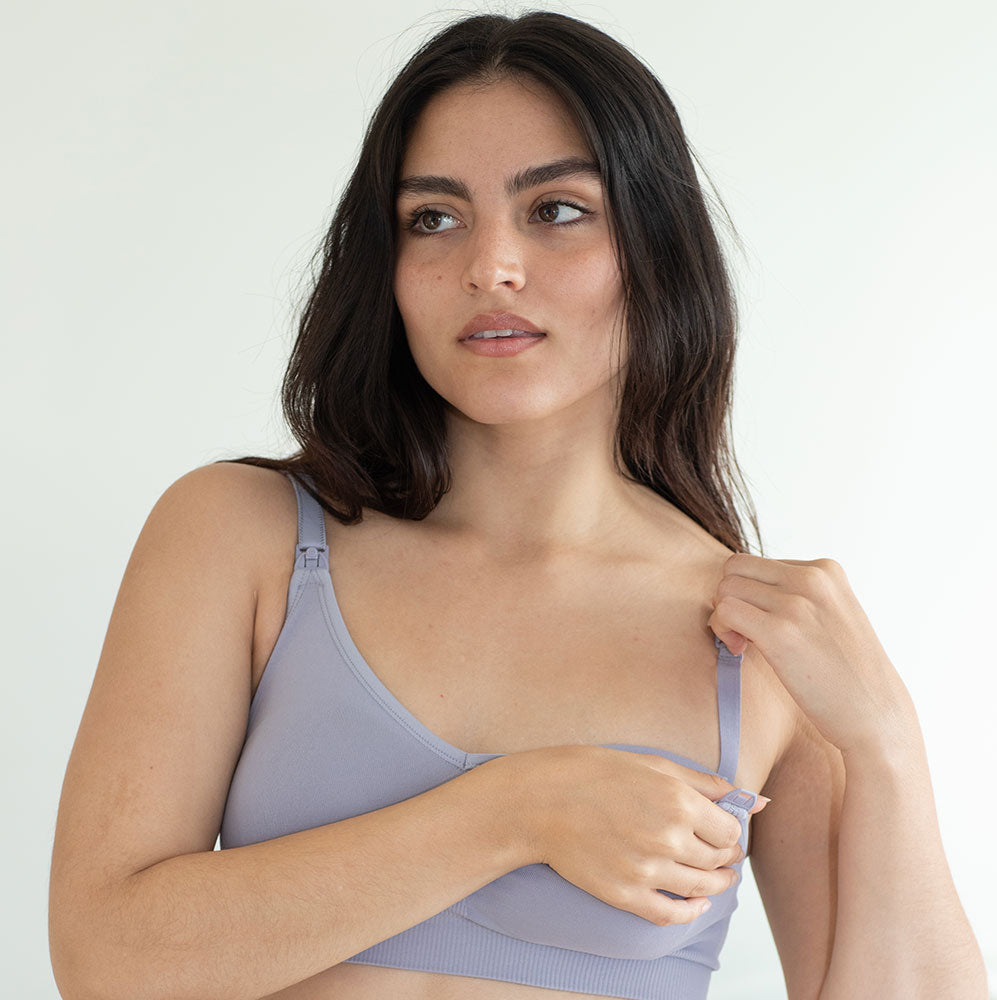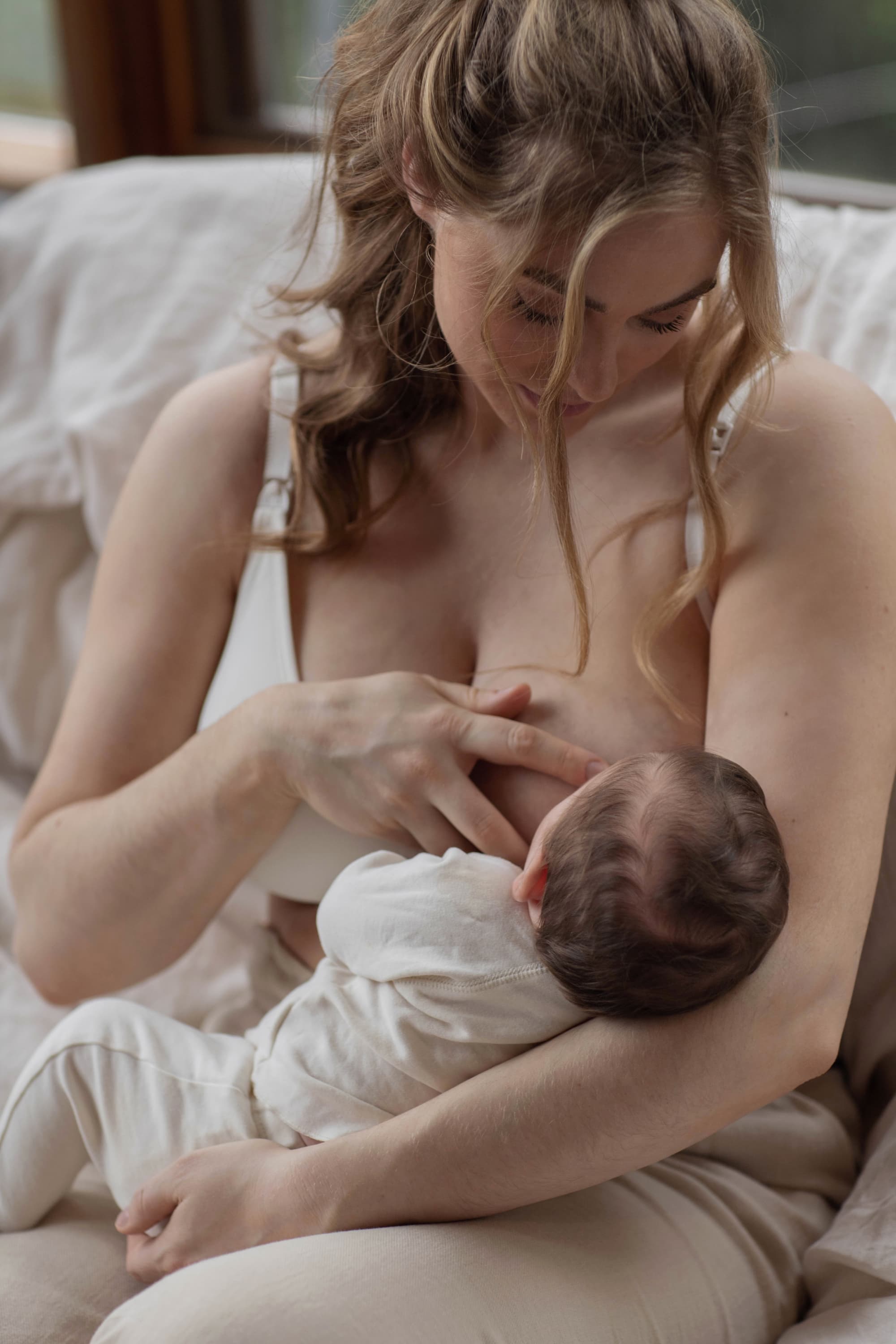Fit Guide
Congratulations! You’re pregnant!
You are probably experiencing quite a few changes to your body, but get ready as there will be more to come your way, as you go through each trimester! We have designed our bras to fit your ever-changing body and keep you feeling comfortable throughout every little inch of growth!
Happy measuring and if you need any help along the way, please reach out to one of our fit experts to help ensure you have the best fit experience.

Try these 3 easy steps to determine your bra size.
Find your size with our easy 3-step measurement, so that you can finally feel comfortable in a well-fitted bra.
Before You Begin
- Have a measuring tape, pen and paper ready
- You will also need to be in front of a mirror
- Wear a non-padded bra that reflects your true shape
- You’ll need to determine your rib band and cup size measurements in inches.
Step 1: Band Measurement
Measure your chest above your breasts - make sure the tape is around your back and under your armpits. Check in the mirror to ensure the measuring tape is parallel to the floor along your back. The tape should be snug around your body without any fingers underneath the tape. If you are in between band sizes, round up or down to the nearest even number. This will be your band measurement (34, 36 etc.).


Step 2: Bust Measurement
Measure around the fullest part of your breasts, over your nipple area. This is a looser measurement than the band measurement. While holding both ends of the tape with one hand at the side of your breast, use your free hand to press the measuring tape in between your breasts to your chest. This will be your bust measurement (37, 38, etc).
Step 3: Calculate Your Size
Subtract your band measurement from your bust measurement. The remainder is your cup size, where each number or inch represents one letter. Combine the band measurement and the cup size for your bra size.
For example, if your band is 34 and your bust is 38:
38 - 34 =4, 4 equates to a D
(1=A, 2=B, 3=C, 4=D, 5=DD, 6=E)
Your bra size is a 34D.

Still need assistance - Chat with a Fit Expert
Do you know your Breast Shape?

Shallow Shaped Breasts
Breasts that are less full at the top of your cup and fuller at the bottom of your cup. Tissue density can range from soft to average. Moms with multiple children, women who have experienced drastic weight fluctuations or mature women tend to have shallow shaped breasts.

Balance Shaped Breasts
Breasts that are equally full at the top and the bottom of your cup. Tissue density is usually average to firm. Average shaped breasts are in proportion with your shoulders and torso width.
Recommended Bras: Body Silk Seamless, Original Nursing Bra, Plunge, Restore, Ballet.

Full Shaped Breasts
Breasts that are very full at the top of your cup. Breasts tend to sit narrow or forward on the body and are generally round. Tissue density is usually average to firm. Full shaped breasts tend to run larger when viewed in proportion with your shoulders and torso width. When fully engorged with breastmilk, most breast will be full shaped during that time.
Recommended Bras: Original Nursing Bra Full Cup, Original Nursing Bra Extended Cup, Original Pumping & Nursing Bra, Body Silk Seamless.
Still Need Help?
Contact our Fit Experts via Live Chat
Monday - Friday, 9am-5pm EST
Changes you can expect during pregnancy
- Breast and nipple sensitivity
- Bra cup size may increase quickly or gradually
- Breasts may become heavy and sore as they start producing milk in the third trimester; cup size may continue to increase
- Breast tenderness may increase
- Band size may increase as your rib cage expands in later pregnancy
- Measure yourself for a bra often to ensure a comfy and supportive fit

More resources for during pregnancy
Navigating Nursing!
If you are just about to start breastfeeding or have already begun your journey you are probably already feeling your breasts changing and most likely outgrowing your regular bras.
A good, comfortable nursing bra is a necessary staple in all every nursing mom’s wardrobes. You are going to be spending a lot of days (and nights) feeding your little one, especially in those early days/weeks, so you will want to make sure you have a bra that can support and comfort you, while you give all the love, and comfort and nourishment to your baby.

Try these 3 easy steps to determine your bra size.
Find your size with our easy 3-step measurement, so that you can finally feel comfortable in a well-fitted bra.
Before You Begin
- Have a measuring tape, pen and paper ready
- You will also need to be in front of a mirror
- Wear a non-padded bra that reflects your true shape
- You’ll need to determine your rib band and cup size measurements in inches.
Step 1: Over Bust Measurement
Measure your chest above your breasts - make sure the tape is around your back and under your armpits. Check in the mirror to ensure the measuring tape is parallel to the floor along your back. The tape should be snug around your body without any fingers underneath the tape. If you are in between band sizes, round up or down to the nearest even number. This will be your rib band size (34, 36 etc.).


Step 2: Bust Measurement
Measure around the fullest part of your breasts, over your nipple area. This is a looser measurement than the rib band measurement. While holding both ends of the tape with one hand at the side of your breast, use your free hand to press the measuring tape in between your breasts to your chest. Subtract your band size from your bust measurement. This is your cup size.
Step 3: Calculate Your Size
Subtract your band measurement from your bust measurement. The remainder is your cup size, where each number or inch represents one letter. Combine the band measurement and the cup size for your bra size.
For example, if your band is 34 and your bust is 38:
38 - 34 =4, 4 equates to a D
(1=A, 2=B, 3=C, 4=D, 5=DD, 6=E)
Your bra size is a 34D.

Still need assistance - Chat with a Fit-Expert
Do you know your Breast Shape?

Shallow Shaped Breasts
Breasts that are less full at the top of your cup and fuller at the bottom of your cup. Tissue density can range from soft to average. Moms with multiple children, women who have experienced drastic weight fluctuations or mature women tend to have shallow shaped breasts.

Balance Shaped Breasts
Breasts that are equally full at the top and the bottom of your cup. Tissue density is usually average to firm. Average shaped breasts are in proportion with your shoulders and torso width.
Recommended Bras: Body Silk Seamless, Original Nursing Bra, Plunge, Restore, Ballet.

Full Shaped Breasts
Breasts that are very full at the top of your cup. Breasts tend to sit narrow or forward on the body and are generally round. Tissue density is usually average to firm. Full shaped breasts tend to run larger when viewed in proportion with your shoulders and torso width. When fully engorged with breastmilk, most breast will be full shaped during that time.
Recommended Bras: Original Nursing Bra Full Cup, Original Nursing Bra Extended Cup, Original Pumping & Nursing Bra, Body Silk Seamless.
Changes you can expect while breastfeeding
- Breasts may become tight, full, and sore in the days following the delivery due to milk production and hormones
- Breasts will likely feel very full before feedings for the first few months causing breast shape to be full temporarily
- Leaking between feedings or from your other breast during feeds may occur
- After 6 months or so, breasts will not be as enlarged and full from milk, even if you are still breastfeeding
- Rib cage may reduce, but may still be larger than pre-pregnancy size
- Measure yourself for a bra often to ensure a comfy and supportive fit

More resources for during nursing
Everyday Comfort
Finding a bra that fits you in all the right places comes down to one thing….knowing your size and finding the style that best suits your breasts to give you the best experience and keep you comfortable all day long, everyday.
Please remember that not all of our styles are sized the same. Be sure to look at the size chart of each style before choosing your size to ensure you are getting the right one based on your measurements today.

Try these 3 easy steps to determine your bra size.
Find your size with our easy 3-step measurement, so that you can finally feel comfortable in a well-fitted bra.
Before You Begin
- Have a measuring tape, pen and paper ready
- You will also need to be in front of a mirror
- Wear a non-padded bra that reflects your true shape
- You’ll need to determine your rib band and cup size measurements in inches.
Step 1: Over Bust Measurement
Measure your chest above your breasts - make sure the tape is around your back and under your armpits. Check in the mirror to ensure the measuring tape is parallel to the floor along your back. The tape should be snug around your body without any fingers underneath the tape. If you are in between band sizes, round up or down to the nearest even number. This will be your rib band size (34, 36 etc.).


Step 2: Bust Measurement
Measure around the fullest part of your breasts, over your nipple area. This is a looser measurement than the rib band measurement. While holding both ends of the tape with one hand at the side of your breast, use your free hand to press the measuring tape in between your breasts to your chest. Subtract your band size from your bust measurement. This is your cup size.
Step 3: Calculate Your Size
Subtract your band measurement from your bust measurement. The remainder is your cup size, where each number or inch represents one letter. Combine the band measurement and the cup size for your bra size.
For example, if your band is 34 and your bust is 38:
38 - 34 =4, 4 equates to a D
(1=A, 2=B, 3=C, 4=D, 5=DD, 6=E)
Your bra size is a 34D.

Still need assistance - Chat with a Fit-Expert
Do you know your Breast Shape?

Shallow Shaped Breasts
Breasts that are less full at the top of your cup and fuller at the bottom of your cup. Tissue density can range from soft to average. Moms with multiple children, women who have experienced drastic weight fluctuations or mature women tend to have shallow shaped breasts.

Balance Shaped Breasts
Breasts that are equally full at the top and the bottom of your cup. Tissue density is usually average to firm. Average shaped breasts are in proportion with your shoulders and torso width.

Full Shaped Breasts
Breasts that are very full at the top of your cup. Breasts tend to sit narrow or forward on the body and are generally round. Tissue density is usually average to firm. Full shaped breasts tend to run larger when viewed in proportion with your shoulders and torso width. When fully engorged with breastmilk, most breast will be full shaped during that time.

Still Need Help?
Contact our Fit Experts via Live Chat
Monday - Friday, 9am-5pm EST
Selecting a bra for Everyday Non-Nursing
- If post-nursing, your breast density has changed due to pregnancy and breastfeeding, and breast shape is typically more shallow
- Breast growth experienced in pregnancy and nursing may reverse themselves over 3 months or so, once you stop nursing
- Rib cage is likely to reduce close to pre-pregnancy size, or may remain slightly larger than pre-pregnancy size
- If you haven’t been pregnant or nursing, breast size and shape may still fluctuate throughout our life for many reasons such as age, health, diet, medications, exercise etc.
- Measure yourself for a bra often to ensure a comfy and supportive fit

















